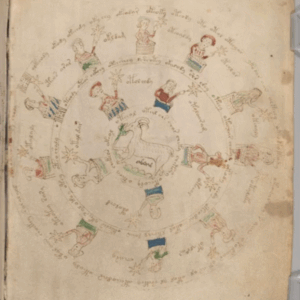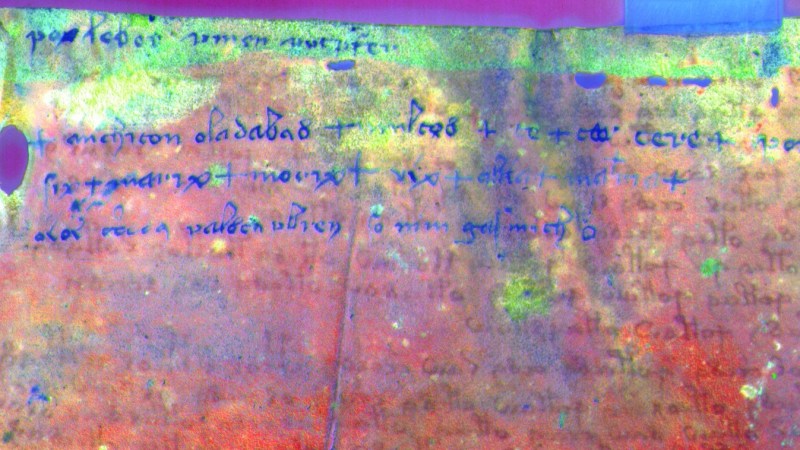The Voynich Manuscript is a medieval codex written in an unknown alphabet and is replete with fantastic illustrations as unusual and bizarre as they are esoteric. It has captured interest for hundreds of years, and expert [Lisa Fagin Davis] shared interesting results from using multispectral imaging on some pages of this highly unusual document.
 We should make it clear up front that the imaging results have not yielded a decryption key (nor a secret map or anything of the sort) but the detailed write-up and freely-downloadable imaging results are fascinating reading for anyone interested in either the manuscript itself, or just how exactly multispectral imaging is applied to rare documents. Modern imaging techniques might get leveraged into things like authenticating sealed packs of Pokémon cards, but that’s not all it can do.
We should make it clear up front that the imaging results have not yielded a decryption key (nor a secret map or anything of the sort) but the detailed write-up and freely-downloadable imaging results are fascinating reading for anyone interested in either the manuscript itself, or just how exactly multispectral imaging is applied to rare documents. Modern imaging techniques might get leveraged into things like authenticating sealed packs of Pokémon cards, but that’s not all it can do.
Because multispectral imaging involves things outside our normal perception, the results require careful analysis rather than intuitive interpretation. Here is one example: multispectral imaging may yield faded text visible “between the lines” of other text and invite leaping to conclusions about hidden or erased content. But the faded text could be the result of show-through (content from the opposite side of the page is being picked up) or an offset (when a page picks up ink and pigment from its opposing page after being closed for centuries.)
[Lisa] provides a highly detailed analysis of specific pages, and explains the kind of historical context and evidence this approach yields. Make some time to give it a read if you’re at all interested, we promise it’s worth your while.
















Also known as schizophrenia.
This was decided iirc
It was effectively like a encyclopedia or something written in old ancient Turkish
decoded/translated
Nope:
https://en.wikipedia.org/wiki/Voynich_manuscript
The Voynich manuscript is still a mystery,
You appear to be referring to Ahmet Ardıç.
https://en.wikipedia.org/wiki/Voynich_manuscript#Ahmet_Ardıç has the (rather short) history of his claims, up to his submission to the Digital Philology journal being rejected.
Note that there has been at least one other claim of deciphering the manuscript since Ahmet’s apparently failed bid, with holes also poked in that theory.
I don’t think this has been correctly deciphered yet, unfortunately – assuming it can be, given that ‘medieval hoax’ is still on the table.
I remember watching something that had some Turkish archeologist looking at it and saw alot of similarities between it and old Turkish
Wasn’t full translated, iirc just enough to know it’s just like an encyclopedia or sort of science almanac
No end of world prophecy in it
It’s been a few years ago, may not have been Voynich but that’s how my my “Mandela effect” remembers
Best this is just some medieval Tolkien making up his own complete language for fun.
Say the guy coming from an era where anybody (almost) can:
– read and write
– print in a blink many copies of a document for dirt cheap
– collect books for little money
– instantly spread documents for the whole planet to read or see, for free
– have a pen offered as goodie from many businesses
– get much paper for free if needed.
A person from the middle-age does hardly develop such a document with so many pages “for fun”. There is for sure a goal behind. And the concept of “fun” was not even existing yet.
Polyglot scholars weren’t uncommon in the middle ages and nobles were very interested in collecting esoteric documents, so maybe it wasn’t made for fun but for ducats?
A few years ago I read a bunch of stories and theories about the Voynich Manuscript. The most believable is that is was a very elaborate hoax, made by some artist. He probably worked months or years on the thing, and when it looked good enough, and his talk was good enough, he could sell it to some rich guy. In those days all sorts of interesting knowledge was kept as most secret as possible, guilds did not want competitors, and certainly not from outsiders. And those secrets extended in all trades, also for mathematicians and medics, etc. A book like this would therefore also be treasured as a valuable secret, and the fool who bought it would probably never ever show it to someone else. Apparently there are a whole lot of similar scam books, but this is one of the most elaborate. These books could be sold for enough money to buy sandwitches (or whatever their equivalent was back then) and a roof above your head for the rest of your life.
And of course the myth is kept alive. A mysterious book attracts much more people and advertisers to a website (or museum, whatever) then an exposed scam.
Your explanation makes the most sense.
More importantly, I now want to start using sandwiches as a metric for measuring material wealth through history. None of this “adjusting for inflation” business or “in today’s dollars” math. I want to know how many sandwiches King Het of Thut could afford on a daily basis.
Apparently Jabba the Hutt could afford lots of sandwiches!
… nor a secret map …
That was my first thought too having just recently reread Foucault’s Pendulum by Umberto Eco where some nerds dream up a spoof / mashup of several ancient occult conspiracy theoris (on account of their day job at a publishing house bringing them into contact with the occasional crackpot along those lines) then discover to their horror that their jest hit close enough to home for some ambiguous characters to crack down on them (though the narrator even at the end is not sure whether they’re just exceptionally vicious crackpots or the vesiges of an ancient occult order, or if that’s even a meaningful distinction to draw).
I have always suspected that its someone’s book of shadows (aka spellbook) written in a a conlang made up by the person.